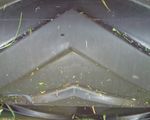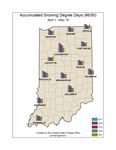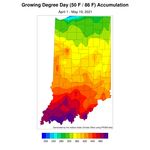Seedcorn Maggots Likely Ending 2021 Run
←
→
Page content transcription
If your browser does not render page correctly, please read the page content below
Issue: 2021.8
May 21, 2021
In This Issue
Seedcorn Maggots Likely Ending 2021 Run
Armyworm Pheromone Trap Report – 2021
Keeping An Eye On Foliar Diseases Of Wheat And Fusarium
Head Blight Risk
Improving Hay Drying Rates With Mower-Conditioner
Adjustments
Growing Degree-day Accumulations Still Lag While Dry
Conditions Linger
Seedcorn Maggots Likely Ending 2021 Run
(Christian Krupke) & (John Obermeyer) Seedcorn maggot pupa, when you find these, damage is done! (Photo Credit: John
Obermeyer)
As we discussed here last week, there have been an unprecedented
number of calls and samples regarding seedcorn maggot damage,
particularly in soybeans. The name of this pest leads you to believe that
it is a corn specialist, but that’s not the case. Seedcorn maggots are
generalist feeders, and will feed on a wide range of decaying or live
organic material. This year, we actually had more reports of heavy
feeding and stand loss in soybeans than corn.
Seedcorn maggot fly on hand. (Photo Credit: John Obermeyer)
At this point, two factors spell the end of the risk of further damage: 1)
the vast majority of maggots are completing development and no
longer feeding, and 2) warmer temperatures will mean that corn and
soybeans planted now or in the near future won’t be at risk. Seedcorn
maggots are only problematic when the seed or young plant is sitting in
cold, wet soils for prolonged periods, not able to outgrow damage.
Having said that, a trend towards earlier planting of soybeans may
mean we will see this again in future years. So, what can we learn from
2021 experiences?
Seedcorn maggot extracted from damaged hypocotyl. (Photo Credit: John
1. If planting early, plant into “clean” seedbeds – this means no
Obermeyer)
dead/dying winter annual weeds, animal manure, or excessive
crop residue. This isn’t always easy to achieve, especially early
1in the spring. But remember that adult females are attracted to Tool (Fig 1.) If you do choose to spray, aim for this early flowering
rotting organic material and although they are not targeting period.
young corn and bean seedlings, they will feed on them if they Our southern neighbors have started reporting multiple diseases in
encounter them. wheat, such as strip rust and Septoria leaf spot. We have yet to see
2. Don’t count on seed-applied insecticides: neonicotinoids many samples or reports here in Indiana. There are a number of
including imidacloprid, thiamethoxam and clothianidin. Many of resources are available to help distinguish wheat leaf diseases, they
the reports we received included damage to treated seeds, and include the Purdue Wheat Field Guide
producers reported that the seed treatments didn’t seem to be (https://ag.purdue.edu/agry/dtc/Pages/WheatFG.aspx) and “Identifying
doing much of anything. Admittedly, this is not a replicated Rust Diseases of Wheat and Barley.”
study and it’s anecdotal information and we don’t have a strong https://www.ars.usda.gov/ARSUserFiles/50620500/Cerealrusts/Rust_Dise
historical dataset on efficacy for these pests, because they are ases_National.pdf
so infrequent. But there’s a good chance that there was not
Samples can always be submitted to the Purdue Plant Pest Diagnostic
much insecticide protecting these seedlings when the maggots
Lab for disease identification and confirmation.
showed up – insecticidal seed treatments are water soluble and
https://ag.purdue.edu/btny/ppdl/Pages/default.aspx
rapidly move off the seed and move with water. Some of that
movement is into the crop, but the vast majority goes
elsewhere. A study in corn demonstrated that less than 2% of
the neonicotinoid applied to the seed ended up in the plant.
Soybeans are likely a similar story. In other words wet,
saturated soils are the perfect recipe for the insecticide to leach
away, just when you need it the most.
The bottom line is that we don’t have the tools to reliably combat this
pest if plants are compromised by prolonged cool weather. Beyond
hoping for good early growing conditions and planting into “clean” and
well-prepared soils, there are few remedies. This year (early planting
followed by prolonged cool period) presented a perfect set of conditions
for seedcorn maggot infestations.
Figure 1. The 72 hour Risk Forecast for Fusarium, the map was generated on 20
May 2021. Orange = high risk, Yellow = medium risk, and Green = low risk for
Armyworm Pheromone Trap Report – 2021 Fusarium head blight on wheat just prior to flowering or the early stages of grain
(John Obermeyer) development. Image credit: http://www.wheatscab.psu.edu/.
Fusarium head blight (FHB) is caused by the fungus Fusarium
Wk Wk Wk Wk Wk Wk Wk Wk Wk Wk Wk graminearium. It infects wheat during flowering, beginning at Feekes
County/Cooperator 10.5.1. Symptoms of FHB will appear as bleached spiklets on the head
1 2 3 4 5 6 7 8 9 10 11
Dubois/SIPAC Ag Center 0 13 3 65 51 12 0 later in the season. Infection can lead to small or shriveled grain kernels
Jennings/SEPAC Ag Center 0 1 0 7 7 2 2 referred to as “tombstones.” In addition to shriveled grain, this fungus
Knox/SWPAC Ag Center 0 6 1 10 35 1 12
can produce mycotoxins such as deoxynivalenol (DON), which can
LaPorte/Pinney Ag Center 27 50 12 393 189 42 231
Lawrence/Feldun Ag accumulated in the infected grain.
14 62 7 434 717 83 79
Center
Randolph/Davis Ag Center 0 0 0 0 0 0 53
Tippecanoe/Meigs 1 0 0 16 31 12 13
Whitley/NEPAC Ag Center 0 0 0 18 20 8
Wk 1 = 4/1/21-4/7/21; Wk 2 = 4/8/21-4/14/21; Wk 3 = 4/15/21-4/21/21;
Wk 4 = 4/22/21-4/28/21; Wk 5 = 4/29/21-5/5/21; Wk 6 =
5/6/21-5/12/21; Wk 7 = 5/13/21-5/19/21; Wk 8 = 5/20/21 – 5/26/21; Wk
9 = 5/27/21-6/2/21; Wk 10 = 6/3/21-6/9/21; Wk 11 = 6/10/21-6/16/21
Keeping An Eye On Foliar Diseases Of
Wheat And Fusarium Head Blight Risk
(Darcy Telenko)
Wheat in Indiana is starting to head out in central Indiana and flowering
will probably start this weekend. During flowering (anthesis) warm,
wet weather with high relative humidity will favor the development of
Figure 2. Wheat beginning to flower and Fusarium head blight infection. (Photo
Fusarium head blight (scab). Due to the recent cooler conditions, the Credit: Darcy Telenko)
risk remains low for the next 72 hours based on the Fusarium Risk
2A number of resources are available to help you make disease
management decisions in wheat.
1) The Fusarium Risk Assessment Tool is available at the following
website. http://www.wheatscab.psu.edu/. This tool estimates the risk of
a Fusarium head blight epidemic (> than 10% field severity) using
weather conditions (temperature, rainfall, and relative humidity)
measured 15 days prior to flowering. See above for the current risk map
– Indiana is still green (low risk for scab development).
Keep in mind that actual disease risk depends heavily on the growth
stage of wheat in your area. We are moving into flowering; the
estimate is most relevant just prior to flowering (Feekes 10.5.1) or the
early stages of grain development. Fusarium head blight risk is highest
when there are three or more days with extended periods of high
relative humidity and moderate temperatures (65 to 80°F) during the
early stages of kernel development.
I wanted to remind you that this tool is available. Farmers and crop
advisors can sign up for alerts from the U.S. Wheat and Barley Scab
Initiative; these can be sent to a cell phone as a text or email. To sign
up visit https://scabusa.org/fhb_alerts.
Mechanical conditioning the crop with rubber rollers (shown in picture) or steel
2) Fungicide Application: A fungicide application might be considered rollers reduces hay drying time. (Photo Credit: Keith Johnson)
if a Fusarium head blight (FHB) susceptible variety is planted, or if you
are worried about scab on your farm. These applications should be
made at Feekes 10.5.1, or early flowering to suppress FHB. Fungicides When conditioning a forage crop, the goal should be to have 90 percent
recommended for FHB and DON include Prosaro, Caramba, Proline, and of the crop’s stems show some signs of a cracking or limpness. No more
Miravis Ace. The use of products containing strobilurin fungicides may than 5 percent of the leaves should show signs of bruising or blackening
result in higher levels of DON accumulation in grain when damaged by from the conditioning process — this is especially important with
FHB. These are not labelled for FHB management. legumes.
Fungicide Efficacy Tables for wheat were just updated and are available Remember, over conditioning forage crops will cause excessive leaf loss
from the Crop Protection Network publications. during the drying process and reduce the crop’s overall yield and
https://crop-protection-network.s3.amazonaws.com/publications/fungici quality. At the same time, under conditioning the crop will make it more
de-efficacy-for-control-of-wheat-diseases- susceptible to rainfall as it will take longer to dry the crop and requires
filename-2021-04-21-154024.pdf more mechanical manipulation to dry the hay.
These tables can help you identify products to use based on your When making the settings to your mower-conditioner, make sure to:
targeted disease. As a reminder follow the label on harvest restriction Alter the conditioning roll gap properly by using the shims
as some products may have 30 to 45 days required between last located on the roll stops. Refer to your owner’s manual.
fungicide application and harvest. Once the full head has emerged Adjust the conditioning roll pressure to ensure proper
flowering will likely occur in 3-5 days, depending on weather and conditioning.
variety. It is time to keep an eye on your fields. Those most at risk Check conditioning with every cutting or crop change.
would be fields that were planted to a Fusarium head blight susceptible Variables such as yield, relative forage species composition,
variety or those with limited rotation that follow a previous crop of and stem diameter change from one crop to the next, or one
wheat or corn. field to the next.
Keep the sickle bar and disk mower blades in good cutting.
Adjust the reel position and speed for adverse conditions, such
as a lodged or tangled crop.
Alter the swath width for drying conditions. Set it wide if the soil
is dry and good drying conditions are expected. Create a narrow
windrow if the soil is wet. This allows the soil to dry between the
windrows. Then, ted the narrow windrows onto the dry parts of
Improving Hay Drying Rates With Mower- the field.
Conditioner Adjustments
(Keith Johnson) Measuring Conditioning Roll Clearance
Harvest of cool-season perennial grasses and perennial legumes is Generally, the mower-condition’s roll clearance should range from 1/16
beginning. Getting a standing forage crop that measures 75 percent inch to 3/32 inch. If the clearance is less than this range, excessive leaf
moisture or more to a safe baling moisture of 18 to 20 percent moisture loss and roll wear can occur. If the clearance is significantly more than
is “easier said than done”. Changing weather fronts pass through every this range, then the crop will not be conditioned as effectively, and
third or fourth day making it a challenge to quickly dry hay. Research slower drying rates can be expected. Most mower-conditioner owner’s
has shown that properly conditioning forage crops is the single most manuals will indicate the proper clearance level and the correct
effective way to reduce curing time. Making the proper settings on your procedure for making adjustments.
mower-conditioner will ensure the best economic return. The following procedure can be used to determine the average roll
3clearance on most roll-type mower-conditioners. To conduct this
procedure safely you must:
Shut off the tractor engine.
Disconnect the mower-conditioner power take-off (PTO) from
the tractor on mechanically driven units.
Disconnect the mower-conditioner PTO hydraulic pump from the
tractor on hydraulically driven units.
Lower the cutting platform.
The procedure’s steps are:
1. Cut three pieces of typical household aluminum foil. Each piece
should be 18 inches long and at least 12 inches wide.
2. Form three separate rolls from the foil strips by wrapping each
one around a length of rod, pipe, or dowel that is 3/8 inch in
diameter. Slide the foil roll off the rod, taking care not to crush
the foil roll.
3. Place one foil roll in the approximate center of the conditioning
rolls. Place the other foil rolls about 1 foot from each end of the Figure 1. U.S. Drought Monitor, May 11, 2021.
conditioning rolls. Place the foil rolls so that they are
perpendicular to the roll’s longitudinal axis.
4. Make sure the cutting platform is fully lowered. This is The El Nino – Southern Oscillation (ENSO) pattern has finally shifted
the only safe way to make this measurement. Furthermore, away from the La Nina phase to the Neutral phase. It is expected that
raising the platform on some mower-conditioners will open and this Neutral phase will continue throughout the summer. For Indiana, a
separate the rolls, preventing an accurate measure of the Neutral phase this time of year has not correlated strongly with either
minimum roll clearance. above- or below-normal temperatures or precipitation, but have slightly
5. Turn the conditioning rolls by hand until the foil rolls come favored higher corn yields. This may imply that temperature and
through completely. precipitation patterns could still be highly variable but average toward
6. The conditioning rolls will crush the foil. Use a digital or dial normal conditions at the monthly or even seasonal time scales.
caliper to measure the thickness of the crushed foil roll to Hopefully, the variability swings back and forth often enough to provide
determine the minimum roll clearance. Take several thickness the necessary relief every few days!
measurements along the length of each foil roll and determine Modified growing degree-day (MGDD) accumulations (Figure 2) are still
an overall average. Take the measurement where the “crimp,” slightly behind the climatological average with the greatest lags in the
or smallest clearance, occurs. The crimped foil thickness should southern counties (Figure 3). However, as Figure 4 shows, for most of
range from 1/16 inch to 3/32 inch. the state MGDD accumulations this year are slightly ahead of where
they were in 2020.
Doing this “measuring the gap” procedure should result in improved
drying rates.
From: Purdue Forage Field Guide, Third Edition. ID-317.
Growing Degree-day Accumulations Still
Lag While Dry Conditions Linger
(Beth Hall)
Abnormally dry conditions are still lingering in parts of Indiana (Figure
1) with interest growing on how much the warmer weather might
exacerbate the situation. Fortunately, the climate outlooks for the next
several weeks and through June are favoring above-normal precipitation
(in addition to above-normal temperatures), so hopefully any dry
periods will be short lived.
Figure 2. Modified growing degree day accumulation from April 1 to May 19, 2021.
4Figure 3. Modified growing degree-day accumulation departures for April 1 through
May 19, 2021 compared to the 1991-2020 climatological period.
Figure 4. Accumulated growing degree days (86/50, April 1 – May 19.
It is the policy of the Purdue University that all persons have equal opportunity and access to its educational programs, services, activities, and facilities without regard to race, religion, color, sex, age, national origin or
ancestry, marital status, parental status, sexual orientation, disability or status as a veteran. Purdue is an Affirmative Action Institution. This material may be available in alternative formats. 1-888-EXT-INFO Disclaimer:
Reference to products in this publication is not intended to be an endorsement to the exclusion of others which may have similar uses. Any person using products listed in this publication assumes full responsibility for their
use in accordance with current directions of the manufacturer.
Pest&Crop newsletter © Purdue University - extension.entm.purdue.edu/newsletters/pestandcrop
Editor: Tammy Luck | Department of Entomology, Purdue University, 901 W. State St., West Lafayette, IN 47907
5You can also read

























































